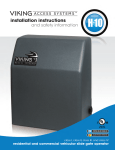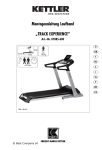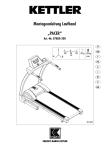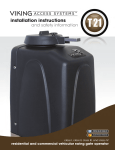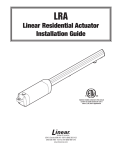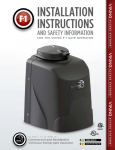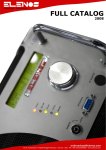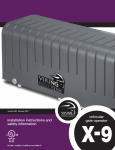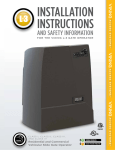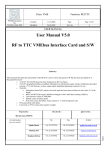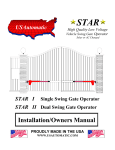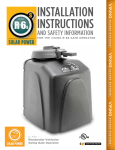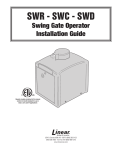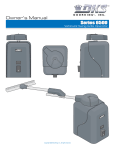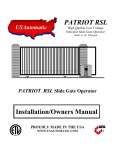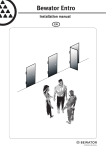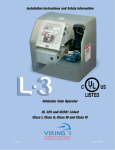Download Q-4™ Installation Manual
Transcript
VIKING installation instructions and safety information VIKING BLUE ENABLED SOLAR EFFICIENT OPERATION class II, class III, and class IV heavy-duty commercial vehicular slide gate operator The Q-4™ incorporates a powerful and efficient DC motor, a high ampacity power supply, an integrated battery back-up system and intelligent controller. The incorporation of these features results in outstanding performance on heavy duty slide gates. The advanced motor control circuit driving the motor guarantees long life. The Q-4™ brings the advantages of DC gate operators into heavy duty applications. the viking Q-4™slide gate operation Q-4 Vehicular Gate Operator • Revision C October 2014 PARTS PARTS DIAGRAM DIAGRAM Item 1 2 3 4 5 6 7 8 9 10 11 12 13 14 15 16 17 18 19 20 21 22 23 24 25 26 27 28 29 30 31 Description Main Chassis Chassis Top Cover Chassis Front Cover Chain Guard Q4 Motor Motor Brake Limit Switch (2) Limit Switch Cam Limit Switch Holder Limit Switch Gear Box Electric Box Control Board Q4 Battery Q4 Modular Power Supply Transformer 15amp Power Supply EMI Board Alarm Limit Switch Harness Power Harness Power Supply Housing Battery Retainer Fuse Kit Chain #50 x 10' x 3 Sprocket 50B25 Idler Pulley Idler Bushing Warning Placard Reset Switch (20 Amp) Reset Switch (10 Amp) 120V Receptacle Overall Dimensions 0.625" 26" 2.60" 20" Part No. VAQ4CH10 VAQ4CTC10 VAQ4CFC10 VAQ4CHGA10 VAQ4MO Q4MOB10 DULS10 L3LC10 L3LH10 DULSG DUEB10 DUPCB10-Q4 DUBAQ4 Q4MPS10 DUTT15 Q4PSH10 Q4EMI DUAL10 Q4LSH Q4POH10 Q4PSH10 Q4BREA10 Q4FUSKT Q4C50CHK Q4S50B25 Q4IDPLY Q4IDBSH DUWPA DUMRS20 DUMRS10 VQ120R 28 23 24 2 8 11 9 5 4 6 25 10 13 27 26 22 Center of Drive Chain 11.75" 13.75" 12 7 1 15 17 15.75" 21 18 16 14 26" 3 14" 30 29 31 19 20 Weight 185 lb. WARNING - For Installation By Qualified Personnel Only. i TECHNICAL SUPPORT 1 800 908 0884 TABLE TABLE OF OF CONTENTS CONTENTS Parts Diagram/Parts List . . . . . . . . . . . . . . . . . . . . . . . . . . . . . . . . . . . . . . . . . . .i Important Safety Information Important Safety Instructions . . . . . . . . . . . . . . . . . . . . . . . . . . . . . . . . . . . . . .2 Important Installation Instructions . . . . . . . . . . . . . . . . . . . . . . . . . . . . . . . . .2-3 Maintenance/General Safety Precautions . . . . . . . . . . . . . . . . . . . . . . . . . . . . . .4 Terminology . . . . . . . . . . . . . . . . . . . . . . . . . . . . . . . . . . . . . . . . . . . . . . . . . .5 Photo Beam (non-contact sensor) Installation . . . . . . . . . . . . . . . . . . . . . . . . . .6 Edge Sensor (contact sensor) Installation . . . . . . . . . . . . . . . . . . . . . . . . . . . . . .7 Manual Release . . . . . . . . . . . . . . . . . . . . . . . . . . . . . . . . . . . . . . . . . . . . . . . .7 Audible Alarm Reset Switch Installation . . . . . . . . . . . . . . . . . . . . . . . . . . . . . .8 Warning Placard Installation . . . . . . . . . . . . . . . . . . . . . . . . . . . . . . . . . . . . . .8 Important Installation Information . . . . . . . . . . . . . . . . . . . . . . . . . . . . . . . . . .9 Specifications . . . . . . . . . . . . . . . . . . . . . . . . . . . . . . . . . . . . . . . . . . . . . . . . .9 Plans of Installation . . . . . . . . . . . . . . . . . . . . . . . . . . . . . . . . . . . . . . . . . . . . .10 Plan of Installation – Concrete Pads . . . . . . . . . . . . . . . . . . . . . . . . . . . . . . . . . .11 Gate Operator Installation Step 1 through 3 – Operator Installation . . . . . . . . . . . . . . . . . . . . . . . . . . . .12-13 Electrical Installation Step 4 – Electrical Installation (120/220 VAC) . . . . . . . . . . . . . . . . . . . . . . . . . .14 Step 5 – Power Connections . . . . . . . . . . . . . . . . . . . . . . . . . . . . . . . . . . . . . .15 Gate Operator Installation Limit Switch Connections . . . . . . . . . Step 6 through 8 – Limit Switch Setup Special Features Fine Tune Limit Setting . . . . . . . . . . Electrical Installation Master/Slave Connections . . . . . . . . . . . . . . . . . . . . . . . . . . . . . . . . . . . . . . . .16 . . . . . . . . . . . . . . . . . . . . . . . . . . . . .16-17 . . . . . . . . . . . . . . . . . . . . . . . . . . . . . . .18 . . . . . . . . . . . . . . . . . . . . . . . . . . . . . . .19 Vehicular Loop Detector Installation Loop Layout Diagrams . . . . . . . . . . . . . . . . . . . . . . . . . . . . . . . . . . . . . . . . . .20 Installation Guidelines . . . . . . . . . . . . . . . . . . . . . . . . . . . . . . . . . . . . . . . . . . .21 Loop Rack Installation . . . . . . . . . . . . . . . . . . . . . . . . . . . . . . . . . . . . . . . . . . . . . .22 Accessory Connections Open Commands; Safety Connections . . . . . . . . . . . . . . . . . . . . . . . . . . . . . . . .23 Radio Receiver . . . . . . . . . . . . . . . . . . . . . . . . . . . . . . . . . . . . . . . . . . . . . . . .24 Guard Station . . . . . . . . . . . . . . . . . . . . . . . . . . . . . . . . . . . . . . . . . . . . . . . . .25 Special Features Auto Open Feature . . . . . . . . . . . . . . . . . . . . . . . . . . . . . . . . . . . . . . . . . . . . . . . .26 Intelligent Obstruction Sensor (Primary Entrapment Protection) . . . . . . . . . . . . .27 Fail Safe/Fail Secure Operation; Hold Open Timer . . . . . . . . . . . . . . . . . . . . . . .28 Optional VikingBlue™ Wireless Master/Slave Installation . . . . . . . . . . . . . . . . . .29 Optional VikingBlue™ Diagnostics Software Installation . . . . . . . . . . . . . . . . . . .30 Troubleshooting . . . . . . . . . . . . . . . . . . . . . . . . . . . . . . . . . . . . . . . . . . . . . . . .31-33 TECHNICAL SUPPORT 1 800 908 0884 1 IMPORTANT IMPORTANT SAFETY SAFETY INFORMATION INFORMATION WARNING - Not following these instructions may cause severe injury or death to persons. IMPORTANT SAFETY INSTRUCTIONS WARNING – To reduce the risk of severe injury or death: 1. READ AND FOLLOW ALL INSTRUCTIONS. 2. Never let children operate or play with gate controls. Keep the remote control away from children. 3. Always keep people and objects away from the gate. NO ONE SHOULD CROSS THE PATH OF THE MOVING GATE. 4. Test the gate operator monthly. The gate MUST reverse on contact with a rigid object or when an object activates the non-contact sensors. After adjusting the force or the limit of travel, retest the gate operator. Failure to adjust and retest the gate operator properly can increase the risk of injury or death. 5. Use the manual release only when the gate is not moving. 6. KEEP GATES PROPERLY MAINTAINED. Read the owner’s manual. Have a qualified service person make repairs to gate hardware. 7. The entrance is for vehicles only. Pedestrians must use separate entrance. 8. Every gate operator installation MUST have secondary protection devices against entrapment, such as edge sensors and photo beams more in particularly in places where the risk of entrapment is more likely to occur. 9. SAVE THESE INSTRUCTIONS. IMPORTANT INSTALLATION INSTRUCTIONS 1. Install the gate operator only when: a) The operator is appropriate for the construction of the gate and the usage Class of the gate (refer to page 5), b) All openings of a horizontal slide gate are guarded or screened from the bottom of the gate to a minimum of 4 feet (1.22 m) above the ground to prevent a 2-1/4 inch (57.2 mm) diameter sphere from passing through the openings anywhere in the gate, and in that portion of the adjacent fence that the gate covers in the open position, c) ALL EXPOSED PINCH POINTS ARE ELIMINATED OR GUARDED, AND d) GUARDING IS SUPPLIED FOR EXPOSED ROLLERS. 2. The operator is intended for installation only on gates used for vehicles. Pedestrians must be supplied with a separate access opening. The pedestrian access opening shall be designed to promote pedestrian usage. Locate the gate such that persons will not come in contact with the vehicular gate during the entire path of travel of the vehicular gate. 3. The gate must be installed in a location so that enough clearance is supplied between the gate and adjacent structures when opening and closing to reduce the risk of entrapment. Swinging gates shall not open into public access areas. 4. The gate must be properly installed and work freely in both directions prior to the installation of the gate operator. Do not over-tighten the operator clutch or pressure relief valve to compensate for a damaged gate. 5. The gate operator controls must be placed so that the user has full view of the gate area when the gate is moving AND AWAY FROM THE GATE PATH PERIMETER, 2 TECHNICAL SUPPORT 1 800 908 0884 IMPORTANT IMPORTANT SAFETY SAFETY INFORMATION INFORMATION WARNING - Not following these instructions may cause severe injury or death to persons. IMPORTANT INSTALLATION INSTRUCTIONS Continued 6. Controls intended for user activation must be located at least six feet (6’) away from any moving part of the gate and where the user is prevented from reaching over, under, around or through the gate to operate the controls. Outdoor or easily accessible controls shall have a security feature to prevent unauthorized use. 7. The Stop and/or Reset button must be located in the line-of-sight of the gate. Activation of the reset control shall not cause the operator to start. 8. All warning signs and placards must be installed where visible in the area of the gate. A minimum of two placards shall be installed. A placard is to be installed in the area of each side of the gate and be visible to persons located on the side of the gate on which the placard is installed. 9. For gate operators utilizing a non-contact sensor (Photo beam or like) in accordance with section 31.1.1 of the UL325 standard: a) See instructions on the placement of non-contact sensors for each Type of application (refer to page 6), b) Care shall be exercised to reduce the risk of nuisance tripping, such as when a vehicle, trips the sensor while the gate is still moving, and c) One or more non-contact sensors shall be located where the risk of entrapment or obstruction exists, such as the perimeter reachable by a moving gate or barrier (refer to page 6). d) Use only Omron E3K-R10K4 photoelectric eye to comply with UL325 10. For a gate operator utilizing a contact sensor (Edge sensor or like) in accordance with section 31.1.1 of the UL325 standard: a) One or more contact sensors shall be located where the risk of entrapment or obstruction exists, such as at the leading edge, trailing edge, and post mounted both inside and outside of a vehicular horizontal slide gate (refer to page 7). b) One or more contact sensors shall be located at the bottom edge of a vehicular vertical lift gate. c) One or more contact sensors shall be located at the pinch point of a vehicular vertical pivot gate. d) A hardwired contact sensor shall be located and its wiring arranged so that the communication between the sensor and the gate operator is not subjected to mechanical damage. e) A wireless contact sensor such as one that transmits radio frequency (RF) signals to the gate operator for entrapment protection functions shall be located where the transmission of the signals are not obstructed or impeded by building structures, natural landscaping or similar obstruction. A wireless contact sensor shall function under the intended end-use conditions. f) One or more contact sensors shall be located on the inside and outside leading edge of a swing gate. Additionally, if the bottom edge of a swing gate is greater than 6 inches (152 mm) above the ground at any point in its arc of travel, one or more contact sensors shall be located on the bottom edge (refer to page 7). g) One or more contact sensors shall be located at the bottom edge of a vertical barrier (arm). h) Use only Miller Edge Model MGR20 or MGS20 edge sensor to comply with UL325 TECHNICAL SUPPORT 1 800 908 0884 3 IMPORTANT IMPORTANT SAFETY SAFETY INFORMATION INFORMATION WARNING - Not following these instructions may cause severe injury or death to persons. MAINTENANCE Remove the Power Harness from the Control Board (refer to page 14) • Clean and lubricate the gate track wheels using the recommended lubricant. • Inspect the track for any signs of cracking or separation. • Check that all mounting hardware of the gate operator is properly tighten. • Ensure that the gate moves freely. • Check for corroded parts and replace if necessary. • Check the battery for the following: Battery connections must be free of corrosion. Battery voltage must be 26 VDC (fully charged battery). Reconnect the Power Harness for the Control Board (refer to page 14) • Check and confirm the proper operation of all safety devices (photoelectric eye, edge sensors or like). • Check and confirm the operation of all installed accessories. • Check and confirm the operation of all special features such as the Intelligent Obstruction Sensor, Hold Open Timer (refer to page 20 to 27) • Check and confirm the operation of the manual release (refer to page 7) • Verify battery backup functionally by turning off the power source (120 VAC and 220 VAC). DO NOT FORGET TO TURN ON THE POWER SOURCE AFTER VERIFICATION. GENERAL SAFETY PRECAUTIONS The following precautions are an integral and essential part of the product and must be supplied to the user. Read them carefully as they contain important indications for the safe installation, use and maintenance. • These instruction must be kept and forwarded to all possible future users of the system. • This product must be used only for that which it has been expressly designed. • Any other use is to be considered improper and therefore dangerous. • The manufacturer cannot be held responsible for possible damage caused by improper, erroneous or unreasonable use. • Avoid operating in the proximity of the hinges or moving mechanical parts. • Do not enter the path of the moving gate while in motion. • Do not obstruct the motion of the gate as this may cause a situation of danger. • Do not allow children to play or stay within the the path of the moving gate. • Keep remote control or any other control devices out of the reach of children, in order to avoid possible involuntary activation of the gate operator. • In case of break down or malfunctioning of the product, disconnect from the main power source. Do not attempt to repair or intervene directly, contact only qualified personnel for repair. • Failure to comply with the above may create a situation of danger. • All cleaning, maintenance or repair work must be carried out by qualified personnel. • In order to guarantee that the system works efficiently and correctly it is important to have the manufacturer’s instructions on maintenance of the gate and operator carried out by qualified personnel. • In particular, regular checks are recommended in order to verify that the safety devices are operating correctly. All installation, maintenance and repair work must be documented and made available to the user. Installer: _____________________________________________________ ____________ Signature Date Contact: _________________________________________________________ _________________________________________________________ 4 TECHNICAL SUPPORT 1 800 908 0884 IMPORTANT IMPORTANT SAFETY SAFETY INFORMATION INFORMATION CAUTION: To Reduce the Risk of Fire or Injury to Persons a) Use only the following type and size of battery(ies): Yuasa NP7-12 b) Do not dispose of the battery(ies) in fire. The cells may explode. Check with local codes for possible disposal instructions. c) Do not open or mutalate the battery(ies). Released electrolyte is corrosive and may cause damage to the eyes or skin. It may be toxic fi swallowed. d) Exercise care in handling batteries in order not to short the battery with conductying materials such as rings, bracelets and keys. e) Change the battery(ies) provided with or identified for use with this product only in accordance with the instructions and limitations specified in this manual. f) Observe proper polarity orientation between the battery(ies) and charging circuit. g) Do not mix batteries of different sizes or from different manufacturers in this product (applies to products employing more than one user replaceable secondary battery). h) A battery-operated product employing a secondary battery supply intended to be charged within the product shall contain specific instructions concerning the proper method of charging. UL325 Gate Operator Classification GLOSSARY RESIDENTIAL VEHICULAR GATE OPERATOR CLASS I – A vehicular gate operator (or system) intended for use in a home of one-to four single family dwelling, or a garage or parking area associated therewith. COMMERCIAL/GENERAL ACCESS VEHICULAR GATE OPERATOR CLASS II – A vehicular gate operator (or system) intended for use in a commercial location or building such as a multi-family housing unit (five or more single family units), hotel, garages, retail store, or other building servicing the general public. INDUSTRIAL/LIMITED ACCESS VEHICULAR GATE OPERATOR CLASS III – A vehicular gate operator (or system) intended for use in an industrial location or building such as a factory or loading dock area or other locations not intended to service the general public. RESTRICTED ACCESS VEHICULAR GATE OPERATOR CLASS IV – A vehicular gate operator (or system) intended for use in a guarded industrial location or building such as an airport security area or other restricted access locations not servicing the general public, in which unauthorized access is prevented via supervision by security personnel. Install the gate operator only when: The operator is appropriate for the construction of the gate and the Usage Class of the gate. 5 TECHNICAL SUPPORT 1 800 908 0884 5 IMPORTANT IMPORTANT SAFETY SAFETY INFORMATION INFORMATION WARNING - Not following these instructions may cause severe injury or death to persons. NOTE - This type of installation DOES NOT reverse the gate all the way back to its limits when the photo-beam is obstructed. This installation is only to protect against entrapment and to comply with UL325. Photo Beam (non-contact sensor) Installation Secondary Entrapment Protection Photo beams or like must be installed to reduce the risk of entrapment. Use only Omron E3K-R10K4 photoelectric eye to comply with UL325 Make the electrical connections of the photoelectric sensor as described here in this page. Care shall be exercised to reduce the risk of nuisance tripping, such as when a vehicle, trips the sensor while the gate is still moving, and One or more non-contact sensors shall be located where the risk of entrapmentor obstruction exists, such as the perimeter reachable by a moving gate or barrier. Turn Switch to 'Light On' Position GND Close Omron Model Stop Open Gnd Guard Station 24VDC Fire Gnd Strike Gnd Exit Gnd Open Commands Center Gnd Reopen Gnd E3K-R10 Open Commands Shown Guard Station Safety Connector Radio Statio Connection '3' (NC1) 24 VDC Power Connections Gate in Closed Position Limit Limit Mag. Lock Hold Open Timer Contact Sensor min. min. 3 0 Mot MAX MAX Overlap Delay Overlap Delay Sensor Obstruction Center Loop TECHNICAL SUPPORT 1 800 908 0884 1.5 Sensor Obstruction Safety Loop UL Sensor Low Pow Radio Rec. Char 6 Center Loop harger Safety Loop Radio Rec. Power UL Sens 0 3or One or more non-contact sensors shall be located where the risk of entrapment obstruction exists, such as the perimeter reachable by a moving gate or barrier. Consult the installation manual for the UL325 device (photo 1.5 Safety about Center beamRadio or like) for UL detail information the usage, Obstruction Rec. andSensor Loop Loop installation maintenance. Overlap Delay Sensor attery Close Close Contact Sensor Stop Hold Open Timer Open Mag. Lock ensor Stop Open Open 30sec Photo Beam Unit Hold Open Timer Mag. Lock Potential Entrapment Area (Shaded) 30 Reflector Stop 1sec 60sec Close off 24 VDC Power Connections 60 Off 1 N.C. UL COM 3 (NC1) Connection '1' (C1) Mag. Lock N.O. Gnd +28v Gnd Radio +28v Gnd Loop Connector Radio Station 1 (C1) IMPORTANT IMPORTANT SAFETY SAFETY INFORMATION INFORMATION WARNING - Not following these instructions may cause severe injury or death to persons. Edge Sensor (contact sensor) Installation For Secondary Entrapment Protection UL Siren Siren GND Close Stop Open GND Master/Slave Close Stop Open Gnd Guard Station Contact Sensor Open Commands 60sec Brake Hold Open Timer Safety Connector Radio Station Stop orClose Open MGR20 Use only Miller Edge 3-sided 30sec activation type MGS20 to comply with UL325 Close Close Brake Stop Open Stop Open Brake Hold Open Timer Openbe located on the inside and outside leading edge One or more contact sensorsHold shall Timer Limit Limit of a swing gate. Additionally, if the bottom edge of a swing gate is greater than 6 inches (152 mm) above the ground at any point in its arc of travel, one or more contact sensors shall be located on MAX min. the bottom edge. 0 3 3 min. 0 Obstruction Overlap Delay 1.5 Overlap Delay Sensor MAX Sensor Obstruction Center Loop Safety Loop UL Sensor Radio Rec. Radiocommunication UL Safety Rec. Sensor Loop Center Loop Safety Loop 1. A hardwired contact sensor shall be located and its wiring arranged so that the Center between theObstruction sensor and1.5the gate operator is not subjected to Loop Overlap Delay Sensor mechanical damage. UL Sens Mag. Lock Motor Sensor Low Battery Power Charger Charger Master/Slave 1sec be installed to reduce the risk of entrapment. Edge sensor or like must Radio Rec. Power Fire off UL Siren 60 Low Battery Guard Station Contact Sensor 30 Motor Sensor Gnd Open Commands Off 1 Mag. Lock Mag. Lock Strike Gnd Exit Gnd Center Gnd Reopen Gnd N.C. UL COM Mag. Lock N.O. Gnd +28v Gnd Radio +28v Gnd +28v Loop Connector Radio Station All Contact Sensors to be Wired In Parallel OPEN LEFT 2. A wireless contact sensor such as one that transmits radio frequency (RF) signals to the gate operator for entrapment protection functions shall be located where the transmission of the signals are not obstructed or impeded by building structures, natural landscaping or similar obstruction. A wireless contact sensor shall function under the intended end-use conditions. Manual Release Remove the top cover. Move the Brake Handle to the Released Position. To resume normal operation, move the Fail Fail Safe/Secure Safe/Secure Handle to the Engaged Position. e k d ra ge B ga n E e k ed ra s B ea l e R TECHNICAL SUPPORT 1 800 908 0884 Brake in Released Position 7 IMPORTANT IMPORTANT SAFETY SAFETY INFORMATION INFORMATION WARNING - Not following these instructions may cause severe injury or death to persons. Audible Alarm Reset Switch Installation Manual Reset for the Audible Alarm UL325 standard requires an audible alarm to go off after two consecutive events detected by the primary entrapment protection of the gate operator (obstruction sensor). The audible alarm will continue to sound for 5 minutes or until a stop command gets actuated. The Stop command can be actuated in two different forms 1. Using the Built in Stop switch on the Control Box or 2. Using an External Stop button within the sight of the gate, away from moving parts of the gate and out of reach of children. 3. Controls intended for user activation must be located at least six feet (6’) away from any moving part of the gate and where the user is prevented from reaching over, under, around or through the gate to operate the controls. Outdoor or easily accessible controls shall have a security feature to prevent unauthorized use. 4. The Stop and/or Reset button must be located in the line-of-sight of the gate. Activation of the reset control shall not cause the operator to start. N.O. 6' COM P STO STOP 5' Minimum UL Siren GND Close Master/Slave Guard Station Open Commands Guard Station Stop Open Commands Open GND Close Stop Open Gnd Fire Manual Stop Button Gnd Strike Gnd Exit Gnd Center Gnd Reopen Gnd UL Gnd +28v Gnd Safety Connector Radio +28v Gnd +28v Radio Station Loop Connector Radio Station UL Siren Siren Out of Reach Master/Slave off 1sec 60sec 60 Close Stop Open 0 3 Overlap Delay Mag. Lock Hold Open Timer min. Motor Sensor MAX Low Battery Center Loop Safety Loop Radio Rec. 1.5 Overlap Delay Sensor Sensor Obstruction Center Loop Safety Loop UL Sens Power Radio UL Safety beCenter AllPower Warning Signs and Placards must installed where visible in 1.5the area Obstruction Rec. Sensor Loop Loop Overlap Delay Charger Sensor of the gate. A minimum of two placards shall be installed. A placard is to be installed in the area of each side of the gate and be visible. UL Sensor Radio Rec. OPEN Charger OPEN TECHNICAL SUPPORT 1 800 908 0884 8 Brake Limit 3 Low Battery Close min. Limit 0 MAX Obstruction Motor Sensor Close Stop Hold Open Timer Stop Open Open Mag. Lock Hold Open Timer 30 30sec Mag. Lock Brake Brake N.C. Off 1 COM Mag. Lock Warning Placard Installation N.O. IMPORTANT IMPORTANT INSTALLATION INSTALLATION INFORMATION INFORMATION CAUTION - FOR USE WITH GATES OF A MAXIMUM OF 60 FT IN LENGTH AND 4000 LBS. IN WEIGHT. WARNING - TO REDUCE THE RISK OF SEVERE INJURY OR DEATH TO PERSONS: Do not allow pedestrian use of this gate! Do NOT Install the gate operator to lift gates 55'-0" OPEN STOP CLOSE Control Control Buttons Control Buttons Locate Control Buttons: 60’ maximum gate length 1. Within sight of the gate, 2. At a minimum height of 5 feet so small children are not able to reach it, and 4000 lb. 3. Away from the gate opening so that someone cannot operate the controls while in the path of the gate, and MAX. 3. Away from all moving parts of the gate. 4000 pounds maximum gate weight Specifications Maximum Gate Length: Maximum Gate Weight: Power Requirements: 55 feet 4000 lbs. 120 VAC Single Phase at 6 Amps Or 220 VAC Single Phase at 3 Amp Operating Temperature: -20°C (-4°F) to 70°C (158°F) TECHNICAL SUPPORT 1 800 908 0884 9 PLANS PLANS OF OF INSTALLATION INSTALLATION All openings of a horizontal slide gate are guarded or screened from the bottom of the gate to a minimum of 4 feet (1.22 m) above the ground to prevent a 2-1/2 inch (57.2 mm) diameter sphere from passing through the openings anywhere in the gate, and in that portion of the adjacent fence that the gate covers in the open position. Gate In Open Position Gate In Closed Position Gate Operator Concrete Pad Track Concrete Pad Track Concrete Pad Gate Operator Gate Operator Concrete Pad Figure A Plan of Front Installation Gate Operator Gate In Open Position Gate In Closed Position Gate Operator Concrete Pad Track Concrete Pad Gate Operator Concrete Pad Track Concrete Pad See Detail Below Gate Safety Guard Route Chain As Shown Fixed Pulley Parts Not Supplied by Viking Access Systems Gate Operator Concrete Pad Detail of Rear Install Chain Route Figure B Plan of Rear Installation 10 TECHNICAL SUPPORT 1 800 908 0884 PLAN PLAN OF OF INSTALLATION INSTALLATION –– CONCRETE CONCRETE PADS PADS Track Gate 2" 10" 4" Minimum Install a Positive Stop at Both Ends 24" of the Track Track Concrete Pad Operator Chassis Gate Operator Concrete Pad 28" Drill for a 1/2" x 3-1/2" Red Head Anchor (4) Places 5.5" 13" Center of Drive Chain Recommended Area for Conduit(s) 5" 11.75"/13.75"/15.75" 18" Conduit Location 4" Minimum 6" 24" See Note 1 Below Grade Level See Note 2 Track Concrete Pad Gate Operator Concrete Pad 1. Follow the local building code to determine the required depth of the concrete pad. 2. Pad measurements recommended by Viking Access Systems are at lease 24” long, 18” wide and 24” deep to ensure the stable operation of the operator, and a minimum of 4” above level grade to avoid any flooding of the machinery. 3. The path of the track must be 10” wide and at least 6” deep to support the weight of the gate. Please consult the local building code for verification and further details. 4. Provide a sufficient number of conduit pathways for all low power accessories such as loop detector leads, maglock, non-contact sensors, contact sensors, safety and other commands. Also provide conduit for the power supply (either 110 or 220 VAC). Extend the conduit the recommended height of 1” above the level of the concrete pad. Install all conduit in the shaded area shown above. TECHNICAL SUPPORT 1 800 908 0884 11 GATE GATE OPERATOR OPERATOR INSTALLATION INSTALLATION Note: Before starting the installation procedure; • Open and close the gate manually, making sure there is sufficient space between the gate and adjacent walls. • Check that the wheels are turning freely on the track and there are no restrictions while pushing the gate to the open and closed positions. • Confirm that there is adequate spacing for the guide rollers and that there are no restrictions throughout the travel of the gate. STEP 1 Before anchoring the chassis to the concrete pad, make sure the gate and operator are LEVEL and PARALLEL. Minimum distance between the operator and gate is 3”. STEP 2 Attach the operator to the concrete pad using Red Head 1/2” x 3-1/2” Anchors. Follow the manufacturers instructions for proper installation. Refer to page 11 for hole center dimensions. 12 TECHNICAL SUPPORT 1 800 908 0884 16 GATE GATE OPERATOR OPERATOR INSTALLATION INSTALLATION Step 3 Chain Installation: Before welding the provided chain brackets, make sure the chain will be in a straight line with, and at the same height as, the chain leaving the gate operator rollers. 17 TECHNICAL SUPPORT 1 800 908 0884 13 1.5 erlap Delay Overlap Delay Sensor uction Sensor Obstruction Center Loop Center Loop eopen Loop Safety Loop UL Sens UL Sensor Radio Rec. Radio Rec. Charger ELECTRICAL ELECTRICAL INSTALLATION INSTALLATION OPEN LEFT OPEN RIGHT Caution – Do not connect the power harness to the board until the installation is ready for verification. STEP 4 24V BAT Black Red The Gate Operator requires a single phase AC line to operate the gate and charge the batteries. A. Turn off the main switch or breaker for the power line being used. B. Move the selector switch on the Incoming Voltage Selector to the proper position (115 for 110 to 120VAC, 230 for 200 to 240VAC). C. Connect the incoming power wires to the terminals as shown in the illustration. D. Turn on the main switch or breaker once the installation is ready for final adjustments. E. To verify that there is AC power to the system, check that the ‘Charger’ LED on the Control Board is on. Fail Safe/Secure 24VAC Green White Power Harness Earth Ground 115V/220V Power Switch 3A FUSE Part # VAEMI Power Ground To Transformer Neutral Hot Tips for proper ground installation A good ground in a gate operator installation will minimize or prevent damage to the operator cause by natural events such as lightning strikes. The following will provide a guideline for proper grounding: 1. Use a ground rod to provide a ground reference. 2. Consult your city code and be aware of under-ground services in the site of the gate operator to prevent inconveniences. 3. Use always a single bonding point for grounding. 4. All ground wires must be as short and as thick as possible. 5. Prevent unnecessary turns or loops in all ground wires. Earth Ground Ground Rod 14 TECHNICAL SUPPORT 1 800 908 0884 18 Motor Sensor ELECTRICAL ELECTRICAL INSTALLATION INSTALLATION Low Battery afety Loop UL Sensor Power Radio Rec. Power Connections Charger STEP 5 OPEN LEFT OPEN RIGHT Connect the wire harness to the “OPEN RIGHT” connector if the gate opens to the right. Connect the wire harness to the “OPEN LEFT” connector if the gate opens to the left. OPEN N EPO Gate Opens Right Motor Sensor Low Battery UL Sensor Power Radio Rec. Charger Inside View OPEN LEFT OPEN RIGHT OPEN OPEN Gate Opens Left Limit Switch Connections The Limit Switches are pre-wired. Should the wires become disconnected, use this diagram to reconnect them. Lower Limit Switch Upper Cam Red White TECHNICAL SUPPORT 1 800 908 0884 NC CO Green NO M NC M CO NO Black Upper Limit Switch 15 Safety Loop Inside View LIMIT LIMIT SWITCH SWITCH SET-UP SET-UP Note: Open and close the gate without interruption every time you change the adjustment. OPEN RIGHT OPEN LEFT Upper Cam sets Open Position UL Siren Siren GND Close Stop Master/Slave Guard Station Close Close Open Commands Brake Brake Open Stop Stop 3 Overlap Delay Safety Connector Hold Open Timer min. Overlap Delay Overlap Delay Sensor MAX Obstruction Center Loop Safety Loop UL Sensor Close the gate to within 6” of desired closed position. Loosen and rotate the cam until the Limit Switch “clicks”. Tighten the cam. 1.5 Close Limit 3 1.5 Radio Rec. OPEN LEFT STEP 3 0 Brake Stop Limit 0 Sensor Obstruction Center Loop Safety Loop UL Sens Radio Rec. Obstruction Sensor Open the gate to the desired open position. Loosen and rotate the ‘Open’ Cam until the Limit Switch “clicks”. Tighten the cam. Fail Fail Safe/Secure Safe/Secure Open Open Open Hold Open Timer min. STEP 2 16 Master/Slave 60 30 MAX Center Loop GND Off 1 Timer Trim Pot Location Safety Loop Close Guard Station Hold Set the Fine Tune Limit Pot to zeroOpen on the Control Board. UL Sensor UL Siren 60sec 30sec Radio Rec. Stop Open Gnd Fire Gnd Lower Cam sets Open Position Open Commands off 1sec STEP 1 Strike Gnd Exit Gnd Loop Connector n Center Gnd Reopen Gnd UL Gnd +28v Gnd Lower Cam sets Close Position Upper Cam sets Close Position This ‘Trim Pot’ can be used to FINE ADJUST the closing position of the gate with a high degree of accuracy (up to 1/16”). The number on the Trim Pot dial sets the number of inches the gate travels after initial set-up. Upper Limit Switch Lower Limit Switch Lower Cam Upper Cam Set Upper Cam in the Direction Shown Set Lower Cam in the Direction Shown TECHNICAL SUPPORT 1 800 908 0884 15 LIMIT LIMIT SWITCH SWITCH SET-UP SET-UP STEP 4 Press both limit switches at the same time to initiate the set-up (the open and close LEDs will blink on the Control Board). Click! Click! Click! Click! Click! Activate Both Limit Switches At the Same Time STEP 5 Open and close the gate from limit to limit without interruption for two complete cycles. 2X Fully Open and Close the Gate 2 Times STEP 6 Use the Fine Tune Limit Pot to perform minor adjustments to the closed position. 6" Initial Setting 2-1/2" First Adjustment Fully Open and Close the Gate After Every Adjustment 1/2" Second Adjustment TECHNICAL SUPPORT 1 800 908 0884 17 Guard Station Open Commands 60sec 60 Safety Connector off Open Stop Overlap Delay Overlap Delay min. Overlap Delay Sensor Radio Ma Loc Hold Open Timer MAX Obstruction Center Loop Safety Loop UL Sensor Radio Rec. Trim Pot Location OPEN LEFT Fail Fail Safe/Secure Safe/Secure 18 Close 3 1.5 Close Limit 3 Obstruction Sensor 0 1.5 Sensor Center Loop Obstruction Safety Loop Center Loop UL Sensor Safety Loop UL Sens Radio Rec. Radio Rec. min. Limit 0 MAX Stop Hold Open Timer Open Mag. Mag. Lock Hold Open Timer 30 The Fine Tune Limit Pot is used to closely set the final stop of the gate travel. The 1sec position can be set to the nearest 1/2” via the markings for the Trim Pot. See page 16-17 for setup procedure. Open Close Stop 30sec TECHNICAL SUPPORT 1 800 908 0884 ster/Slave Off 1 Mag. Lock Fine Tune Limit Setting Close Guard Station Stop Open Commands Open GND Close Loop Connector SPECIAL SPECIAL FEATURES FEATURES Stop Open Gnd Fire Gnd Strike Gnd Exit Gnd Center Gnd Reopen Gnd UL Gnd +28v Gnd Radio Station Master/Sla ELECTRICAL ELECTRICAL INSTALLATION INSTALLATION –– MASTER/SLAVE MASTER/SLAVE Master/Slave Connections Outside Interconnecting Conduit Opens First Inside Master Unit Slave Unit Caution – Do not run Master/Slave communication cable in the same conduit as the power supply (120-220V) cable. Use 18 AWG stranded wire with foil overshield and drain wire or better. Conduit Shielded Cable NOTE: Use 16 Gauge Wire for runs up to 100' Shield Wire UL Siren GND Close UL Siren Master/Slave UL Siren Guard Station Master/Slave Guard Station Stop Master/Slave Open GND Close Stop Open GND Close Stop Open GND Close Stop Open Guard Station Guard Station UL Siren Master/Slave The control board provides a connector for master/slave connectivity. This connector will allow synchronized operation with a second gate operator. Wire the operators as shown above and interconnect the two operators as follows: Master Board Slave Board GND . . . . . . . . . . . . . . . . . . . .GND Close . . . . . . . . . . . . . . . . . . .Close Stop . . . . . . . . . . . . . . . . . . . .Stop Open . . . . . . . . . . . . . . . . . . .Open Shield (to Earth) Shield (to Earth) Purpose Reference Close Command Stop Command Open Command Note: It is recommended to connect all external devices and set timer and overlap delay control on the master unit. Ensure Slave Control Board has timer set to ‘OFF’ to allow the Master to control the timer. TECHNICAL SUPPORT 1 800 908 0884 19 O ut s id e VEHICULAR VEHICULAR LOOP LOOP DETECTOR DETECTOR INSTALLATION INSTALLATION e op tsid Lo Ou open Re ide Ins p Loo n e op Re p Loo In si de t Exi Note: Not all loops may be necessary for every installation. Check local regulations and accepted bestpractice design requirements. A Outside Reopen Loop 5' A Inside Reopen Loop Exit Loop Inside Outside A A Gates in Closed Position 20 Dimension A – 5’ for Single Gate Operator 6’ for Master/Slave Gate Operator TECHNICAL SUPPORT 1 800 908 0884 VEHICULAR VEHICULAR LOOP LOOP DETECTOR DETECTOR INSTALLATION INSTALLATION WARNING – Consult the installation instructions from the loop detector manufacturer. The following statements are provided as a guide but different requirements may be required by the vehicular loop detector manufactu rer. Guidelines for Vehicular Loop Detector Installation 1. Prevent sharp corners in the geometry of the loop sensor. 2. Install the appropriate number of turns for your loop geometry based on the loop perimeter. Use Table C (below) as a guide. 3. Use XLP (cross-linked-polyethylene) type of wire. This wire reduces the effects of moisture and other environmental events in altering the functionality of the vehicular loop detector. 4. Twist the lead wire at least 6 turns per foot. 5. Use BACKER-ROD to minimize damage to the loop detector wire prior to using the sealant. 6. Place the loop detector wire and adjust the sensitivity of the vehicular loop detector unit in a way to minimize the effects of the gate over the loop detector wire. IMPORTANT – Some of the following parameters may affect the proper functionality of the vehicular loop detector (consult the installation manual and the manufacturer of the vehicular loop detector). • Gate size, • Number of turns in the loop sensor wire; • Distance from the loop sensor wire to the gate either at the open or close position. Saw Cut 1" Min. Sealant Backer-Rod Vehicular Loop Detector Wire (3 Turns Shown) Table C – Recommended Number of Turns Perimeter in Feet Number of Turns 10 5 20 4 30-40 3 50-100 2 Provide Additional Saw Cuts to Eliminate Sharp Corners 1/8" to 1/4" Saw Slot Continuously Wind Wire in Loop Slot for the Required Number of Loops (2 Loops Shown) TECHNICAL SUPPORT 1 800 908 0884 Twist Wire Outside the Loop 6 Twists/Foot Until Its Connection to the Loop Detector 21 LOOP LOOP RACK RACK INSTALLATION INSTALLATION Looprack – Viking Part # VA LR Looprack Wiring Harness – Viking Part # VA LRH Outside Twist Wire Outside the Loop 6 Twists/Foot Until Its Connection to the Loop Rack Viking Loop Rack Exit Center Outside Safety Loop Reopen Exit OP 28V Gnd Exit Center Reopen Center Loop CN Center RO Reopen Inside Safety Loop Exit Loop Control Board Connector Inside Loop Connector UL iren Siren GND Close Stop Open Master/Slave GND Close Stop Open Guard Station Open Commands Stop Open 3 1.5 Overlap Delay 1.5 Overlap Delay Overlap Delay Safety Connector Radio Station Mag. Lock Hold Open Timer min. Motor Sensor MAX Low Battery Sensor Obstruction Center Loop TECHNICAL SUPPORT 1 800 908 0884 Close 3 0 Brak ake Limit Brake Limit Close Close Stop Open Sensor Obstruction Sensor Stop Open 0 min. Obstruction Center Loop Gnd Hold Open Timer Safety Loop Safety Loop Center Loop UL Sensor UL Sensor Safety Loop UL Sens Radio Rec. Power Charger 22 Radio Rec. Master/Slave 60 30 MAX Radio Rec. Charger Fire Off 1 Mag. Lock Hold Open Timer Low Battery Power Guard Station 60sec 30sec Motor Sensor Gnd Open Commands off 1sec Mag. Lock Strike Gnd Exit Gnd Center Gnd Reopen Gnd N.C. UL COM Mag. Lock N.O. Gnd +28v Gnd Radio +28v Gnd +28v Loop Connector Radio Station UL Siren O ACCESSORY ACCESSORY CONNECTIONS CONNECTIONS Safety Connections 1 Safety Loop Detector Photo Beam 2 Edge Sensor Center Loop Detector 1 Hold Open Timer op Open 3 Overlap Delay min. Overlap Delay Open ve Safety Connector Hold Open Timer 1.5 GND Radio Station Mag. Lock Motor Sensor MAX Low Battery Center Loop Sensor Obstruction Close Stop Open Guard Station Safety Loop Radio Rec. UL Sensor Open Commands Guard Station Ma 60 Close Open Stop Close Stop 3 Overlap Delay 1.5 Overlap Delay Overlap Delay Strike Gnd Exit Gnd mands Safety Connector Loop Connector Center Gnd Reopen Gnd UL Hold Open Timer min. Power Charger Safety Connector Radio Station Mag. Lock Motor Sensor MAX Low Battery Center Loop Sensor Obstruction Gnd +28v Open Co 23 Off 1 off 1sec 60sec 60 Safety Loop UL Sensor Radio Rec. Power Charger Radio Station N.C. Mag. Lock COM Gnd Radio +28v Gnd +28v 30sec Hol 30 OPEN L OPEN RI N.O. Limit 3 Obstruction Sensor 0 1.5 Sensor Center Loop Obstruction Center Loop Safety Loop UL Sens Radio Rec. Safety Loop Close Stop Limit 0 min. Open Open Hold Open Timer 30 Mag. Lock Hold Open Timer MAX TECHNICAL SUPPORT 1 800 908 0884 Gnd Off 1 30sec Radio Station 22 1.5 Overlap Delay 60sec Fail Fail Safe/Secure Safe/Secure UL Sensor Fire Gnd Strike Gnd OPEN LEFT off 1sec Photo Beam Radio Rec. 3 Reopen Photo Beam Low Battery Charger 0 Obstruction Sensor Open Commands Motor Sensor Inside Open Center Loop Outside Power Sensor Center Loop Safety Loop Exit Center Gnd Gnd UL Sens Radio Rec. Reopen Mag. Lock COM As an alternative to the Outside Reopen Loop, N.C. a photo beam unit can be used as shown. Mag. Lock Gnd UL Gnd +28v OPEN RIGHT Gnd Radio +28v Gnd +28v N.O. 2 Loop Connector Radio Station Safety Loop 0 Low Battery Obstruction min. E Sto Limit FIR MAX UL Sensor Open 60 30 Mag. Lock The edge sensor and/or the photoelectric beam must be UL325 compliant devices. Motor Sensor Radio Rec. Open Fire Hold Open Override Timer Keypad G 60sec 30sec Charger Gnd Off 1 off 1sec Power Fire Open Commands Open Commands Exit Loop Detector Gnd Strike Gnd Mag. Lock COM The SECONDARY ENTRAPMENT PROTECTION N.C. like the edge sensor and the photoelectric beam MUST BE PART OF EVERY SINGLE INSTALLATION to prevent pedestrian or Mag. animal entrapment (see pages 6 and 7). Lock Exit Loop Connector Gnd Center Gnd Reopen Gnd UL Gnd +28v Gnd Radio +28v Gnd +28v Vehicle loop detectors must be installed to decrease the possibility of vehicle Radio Station entrapment on the gate (see page 20). N.O. Open Commands Connection Locations ACCESSORY ACCESSORY CONNECTIONS CONNECTIONS Radio Receiver When connecting the Radio Receiver carefully verify the proper connections. The maximum voltage that the control board provides for external accessories is the maximum voltage of the battery, which is about 28 volts. In the event of an electrical short the board will protect itself by shutting down and will remain shut down until the short is corrected. The control board provides two modes of operation that a radio receiver can control the gate: External Accessories +24VDC Gnd NO Open-Stop-Close COM Exit Gnd Center Gnd Reopen Gnd Safety Connector Radio Station Off 1 N.C. Mag. Lock COM UL Loop Connector Radio Station N.O. Gnd +28v Gnd Radio +28v Gnd +28v 1. By having the radio receiver connected as illustrated and with the Hold Open Timer OFF (see page 28): Every command of the radio transmitter will control the gate as follow: a) First command opens the gate, b) Second command stops the gate and c) Third command closes the gate d) Any subsequent commands will continue in the same order to control the gate. This type of configuration is not recommended for a commercial installations. off 1sec 30 Mag. Lock Mag. Lock Mag. Lock Ho Open Only 2. By having the radio receiver connected as illustrated and with the Hold Open Timer ON (see page 28): Each command of the radio transmitter is ALWAYS AN OPEN COMMAND to the gate. Motor Sensor Motor Sensor X Low Battery Low Battery Center Loop n Safety Loop UL Sensor 23 Fail Fail Safe/Secure Safe/Secure Center Loop Safety Loop Center Loop Safety Loop UL Sensor Radio Rec. OPEN LEFT Power Charger TECHNICAL SUPPORT 1 800 908 0884 Radio Rec. UL Sens Charger Radio Rec. Power OPEN RIGHT 24 MA ACCESSORY ACCESSORY CONNECTIONS CONNECTIONS N.O. Note: All controls are normally open. N.O. N.O. OPEN STOP CLOSE COM UL Siren Master/Slave Guard Station Close Close Close Open Commands Brake Brake Open Stop Stop Limit Limit 3 0 3 1.5 Overlap Delay 1.5 Overlap Delay Overlap Delay Safety Connector Radio Station Mag. Lock Hold Open Timer min. 0 Motor Sensor MAX Low Battery Obstruction Sensor Stop Brake Open Open Sensor Sensor Center Loop Center Safety Loop UL Sensor Radio Rec. Power Rec. Sensor Loop Open switches must beLoop Normally type of switch, and can share the same common (ground). Obstruction Charger OPEN RIGHT OPEN LEFT Place the control switch box within sight of the gate, away from moving parts of the gate and out of reach of children. Fail Fail Safe/Secure Safe/Secure 24 Siren GND Close Stop Open GND Close Stop Open Gnd min. Obstruction Safety Center Loop UL Safety Loop UL Sens Radio Rec. Radio Fire The guard station provides control of the MAX gate operator to open, stop and close the Low Battery gate. Power Charger All three Gnd Hold Open Timer 30 Mag. Lock Hold Open Timer Motor Sensor Master/Slave 60sec 30sec Guard Station Guard Station 60 off 1sec Mag. Lock Strike Gnd Open Commands Off 1 Connection Locations Exit Gnd Center Gnd Reopen Gnd N.C. UL COM Mag. Lock N.O. Gnd +28v Gnd Radio +28v Gnd +28v Loop Connector Radio Station UL Siren TECHNICAL SUPPORT 1 800 908 0884 25 SPECIAL SPECIAL FEATURES FEATURES Auto-Open Feature N.O. TECHNICAL SUPPORT 1 800 908 0884 +28v Gnd Radio Rec. Reopen Loop UL Sens Radio Rec. Mag. Lock Mag. Lock Mag. LOCK Lock MAG. Gnd +28v Radio S Gnd UL Gnd Reopen Safety Loop Connector Connector Gnd Center Off 1 N.C. COM Gnd Exit Gnd Strike Gnd Fire Open Commands Gnd Open Stop Close Guard Station GND Open Stop Close GND Siren Mag. Lock Mag. LOCK Lock MAG. +28v Radio Gnd +28v Gnd UL Gnd Reopen Gnd Center Master/Slave Radio Station UL Sensor 30 60 Motor Sensor Check Motor Safety Loop Connector Connector26 Safety Loop MAX Hold Open Timer Low Battery UL Siren Center Loop Sensor min. Open Stop Brake Power Mag. Lock Center Loop Sensor Radio 0 Obstruction 1.5 Overlap Delay 3 Obstruction Once you put the “jumper” on the control board the “Check Motor” light will come on Hold Open indicating that the Auto-Open feature has been Timer enabled. Close Open Stop Brake Charger Radio Rec. UL Sens UL Sensor Overlap Delay Close OPEN LEFT C35 C36 Radio Rec. Reopen Loop Loop Safety Loop OPEN RIGHT JP3 ter op To enable the Auto-Open feature : Use the “jumper” provided and place it on the pinheader of JP3, on the terminals close to C35 as the illustration indicates. 24V BAT Fail Safe/Secure OPEN LEFT 24VAC The Auto-Open feature in Viking Gate Operators enables the following functionality in the event of power failure: a) Open the gate in case of power failure (120 or 220 VAC). b) Keep the gate at the open position as long as the there is no power. c) Resume to normal operation when the power has been restored. The Auto-Open feature allows proper operation while opening in case of power failure for the following devices: • All accessories, • All safety devices, Fail • All entrapment protections. Safe/Secure The only operation that can not be executed while opening in case of power failure is to CLOSE the gate. Mag. Lock Hold Open Timer SPECIAL SPECIAL FEATURES FEATURES Stop Stop Hold Open Timer Open Open Mag. Lock Mag. Lock Hold Open Timer 30 30sec Limit Intelligent Obstruction Sensor (Primary Entrapment Protection) min. min. 3 Overlap Delay 1.5 Overlap Delay Overlap Delay Motor MAX Low Ba Obstruction Sensor 0 1.5 Sensor Obstruction Center Loop Center Loop Sensor Safety Loop Safety Loop Center Loop UL Sensor Power Radio Rec. Charge Charger UL Sensor Safety Loop Radio Rec. UL Sens Radio Rec. Power 3 w Battery 0 MAX Obstruction r Sensor Trim Pot Location OPEN LEFT Turning the Trim Pot clockwise increases the sensitivity. Turning the Trim Pot counterclockwise decreases the sensitivity. The Obstruction Sensor detects obstructions in the path of the traveling gate. The Trim Pot for the Obstruction Sensor adjusts the sensitivity level that triggers the Sensor. When the Obstruction Sensor detects an obstruction it will: 1. Stop the gate’s movement and reverse it momentarily. 2. Bring the gate to a resting position. 3. Disable the Hold Open Timer feature until the Gate Operator receives a new command. If another obstruction is detected before the gate reaches either limit it will: Fail Fail Safe/Secure Safe/Secure 1. Stop the gate’s movement. 2. Bring the gate to a resting position. 3. Disable the Gate Operator. UL325 standard requires an audio alarm to go off after two consecutive entrapment events sensed by the Inherent Entrapment Protection of the Gate Operator. The audio alarm will sound for a period of 5 minutes or until the “Stop” Button is pressed (see page 8 for remote installation of a “Stop” Button). 24 TECHNICAL SUPPORT 1 800 908 0884 27 SPECIAL SPECIAL FEATURES FEATURES Fail Safe/Fail Secure Operation The gate operator contains a unique design that allows the user to move the gate manually in case of power failure. Fail Safe: By moving the Brake Handle to the Released positon: The gate can be moved manually with a relatively low amount of force during a power failure Fail Secure: By moving the Brake Lever to the Engaged postion: The gate can not be moved during a power failure. Brake in Engaged Position Brake in Released Position e k d ra ge B ga n E e k ed ra s B ea l e R 1 GND Close Stop Open Guard Station Open Commands Stop Open Limit 3 3 Overlap Delay 1.5 Safety Connector min. Motor Sensor MAX Low Battery Center Loop Safety Loop UL Sensor 1.5 UL Safety Center TECHNICAL 1 800 908 0884 Obstruction Overlap Delay25 Sensor LoopSUPPORT Loop Sensor Overlap Delay Radio Station Mag. Lock Hold Open Timer Sensor Center Loop Obstruction 0 Close Limit Close Close Stop Open min. Stop Open 0 MAX Safety Loop Sensor Obstruction Radio Rec. Radio Rec. UL Sens Power Charger Charger Radio Rec. Power 28 Gnd Hold Open Timer Note: The Hold Open Timer affects the “radio receiver command” and the sequence of Motor Sensor operation forLow theBattery gate (see page 24). Fire Hold Open Timer 30 Mag. Lock Mag. Gnd 60sec 30sec Lock If this feature is not needed, turn the Trim Pot clockwise to the “off” position. Guard Station 60 off 1sec 1 Strike Gnd Exit Open Commands Off 1 Mag. Lock N.O. The Hold Open Timer function holds the gate at COM the open position for a predetermined amount N.C. of time, prior to closing automatically. Set the Timer to the desired time, from 1 to 60 seconds. Gnd Loop Connector Center Gnd Reopen Gnd UL Radio Station Hold Open Timer Gnd +28v Gnd Radio +28v Gnd +28v Connection Location 24 + 28 + G nd N io o di Ra Ra d . .O v at St 28 M O C . .C N G . A + LO C K 2 8v G nd L U or ct ne n o C G nd Reo er rg ha er ery C w att tor Po B o w M Lo ck he C M Lo ag ck . pen op Lo nd G 24V BAT M G nd n io v OPTIONAL OPTIONAL VIKING VIKING BLUE BLUE INSTALLATION INSTALLATION Fail Safe/Secure C G nd er en t i m n pe O n io at St Mag. LOCK Lock MAG. COM 41RN 9J D: T CI FC ial # r e S N.O. Gnd +28v Radio Gnd +28v e av Sl r/ ts e a M OPEN RIGHT 36 C 35 JP 3 C 2 JP Mag. Lock d) (re ed en) ect re onn ted (g c dis nec 1 con Radio Station Gnd UL Gnd Reopen Gnd Center Off 1 Gnd rd ua G X A M n. OPEN LEFT Radio Rec. UL Sens Reopen Loop re il cu Fa Se / fa e S Center Loop 30 Exit Gnd N.C. 29 D LUE NGB VIKI lo se C Sensor op 60 St Check Motor Br ak e Obstruction O n pe Hold Open Timer D N G Strike C lo se Gnd p 0 St o Fire n 1.5 ds an m om C pe O se lo C Open nd G op O ve D rla el p ay Gnd re Fi St 3 5 1. Overlap Delay nd G n 0 n 3 S pe O bs t or tio ns ru c Se Install Install Jumper Install Jumper JP3 Charger JP3 Power JP3 Low Battery Safety Loop Connector Connector TECHNICAL SUPPORT 1 800 908 0884 Match up Match up White JP2 Dots Match up White Dots JP2 JP2 O T C Open Commands O Ti pe m n er C e Lo nte op r A A n e H ol d EN FT B V Open tr ik 30 Re o L o pe op n O P LE V 4 op G nd 60 U Se L ns T 4 2 Overlap Delay it O ff 1 Ra Re dio c. R H 2 1. Decide which Operator will be the Master and which will be the Slave. 2a. Install the “Master” Viking Blue Module on the Master Control Board. 2b. Install the “Slave” Viking Blue Module on the Slave Control Board. Use care in connecting the plug to the Control Board. The pins are small and easily bent. Match the white dot on the plug to the white dot on the control board (near the JP2 legend as depicted). 3. Install the Jumper (near the JP3 legend depicted). Viking-Blue requires this jumper to operate as a Master/Slave device. The Obstruction Sensor Battery” LED will turn ON, indicating “Low the Control Board is ready for use with the Viking-Blue Module. 4. Attach the Viking-Blue Module to the min. MAX Operator. For better communication and performance follow these guidelines: • The Module must be under the Operator Cover. Hold Open • The Modules must be facing each other as Timer much as possible. The Light on the Viking-Blue module will turn green upon connection between the other Module. Be sure to test your Master/Slave communication. Ex P EN IG VikingBlue Wireless Master/Slave +28v O WARNING – Connecting the plug backwards can result in damage to the Control Board and will render the Viking-Blue Module useless. op Lo L G nd en te r Ex it St rik ds an m om C G nd G nd G nd n pe O Fi re 60 30 pe O Re o L o pe op n n n io at St p e av Sl r/ ts e a M op St C lo se X A M rd ua G 36 C JP 3 C 35 Br ak e . m in Radio Rec. Mag. LOCK Lock MAG. Mag. Lock N.C. COM N.O. +28v Gnd +28v Radio Radio Station If you are using the computer: • Hold the computer near the Gate Operator. • Run the application by clicking the icon on the desktop. • Select “Setting” in the top right of the screen. If you are using a PDA: • Hold the PDA near the Gate Operator. • Select “Start” and “Programs”. • Click the Viking-Blue Application. • Select “Connection” on the toolbar. Gnd +28v Gnd Si re n N D se JP3 Charger JP3 JP3 Power Check Motor 30 G C lo OPEN RIGHT pe n St op O ev D rla el p ay Install Install Jumper Install Jumper 1. Insert CD into host computer 2. Install MS ActiveSync (check your computer, it may already be installed to communicate with a PDA or smart phone. 3. Install Viking Blue software Select Install Viking-Blue for PC (to have the computer to communicate with the Operator) Select Install Viking-Blue for PDA (to have the PDA to communicate with the Operator) WARNING: If this PDA is a new device, turn off all options when syncing with the computer. For either installation, follow the steps in the user manual. 4. Plug the Viking Blue Module into the Viking Gate Operator Control Board. WARNING: Connecting the plug backwards can result in damage to the Control Board and will render the Viking Blue Module useless. Use care in connecting the plug to the Control Board. The pins are small and easily bent. Match the white dot on the plug to the white dot on the control board (near the JP2 legend as depicted). 5. Install the Jumper (near the JP3 legend depicted). Viking-Blue requires this jumper to operate. The “Low Battery” LED will turn ON, indicating the Control Board is ready for use with the Viking-Blue Module. 6. Open Viking Blue software on the chosen device. O n 3 5 1. 2 D N G pe c 0 bs tr u JP C lo se O O Se tio ns n or OPEN LEFT St o H lo d O Ti pe m n er C e Lo nte op r UL Sens e O ff 1 U Se L ns Match up Match up White Match up JP2 Dots White Dots JP2 JP2 Low Battery or tor UL C c he C n on C pen Reo G nd 24V g. Ra Re dio c. OPTIONAL OPTIONAL VIKING VIKING BLUE BLUE INSTALLATION INSTALLATION • Click “Search” (looking for available Viking devices). • Select the Operator you want to communicate with. • Click “Connect” to start communication. The Light on the Viking-Blue module will turn green upon connection to the Computer or PDA. Follow the steps in the user manual. TECHNICAL SUPPORT 1 800 908 0884 TROUBLESHOOTING TROUBLESHOOTING Gate does not run – Check motor indicator comes ON Check all motor connections to be fully engaged. Refer to page 15 and 16. Ensure that the motor connections are properly connected, Refer to page 15. Check that all motor cable connections, junctions and extensions are properly connected and color-coded. Refer to page 15. Check the 15 Amp fuse in the control board. Ensure that the manual reset switch is at the ‘reset’ position. Refer to page 7 and 28. Gate does not run – Check motor indicator is OFF Check all motor connections to be fully engaged. Refer to page 15. Check that limit switches are connected to the common and the normally close position refer to page 16. Check that the stop command is not active. Refer to page 8 and 25. Check that the UL command (photo beam and/or edge sensor) is not active. Refer to page 6, 7 and 23. Check that the vehicular loop detectors are working properly. Refer to page 20, 21 and 23. Check that the radio command is not active. Refer to page 24. Ensure that you external accessories are working properly. Check the 4 Amps fuse in the control board Ensure that you power cables are adequate in voltage and properly connected. Refer to page 14. Gate does not run – Power failure Check the 15 Amp battery fuse. Check the battery connections and cables. Check the voltage of the battery. Gate does not run – Obstruction sensor ON and audio alarm is SOUNDING Ensure that the gate path is clear of obstructions. Note: To stop the audio alarm, use the stop command. Refer to page 8 and 25. Adjust the trim pot of the obstruction sensor. Refer to page 27. Gate runs, stops and reverse momentarily – Obstruction sensor ON and audio alarm OFF Ensure that the gate path is clear of obstructions. Check for proper functionality and lubrication of the gate and hardware (hinges and the like). Adjust the trim pot of the obstruction sensor. Refer to page 27. Gate ignores the limit switches Check that the open limit switch and close limit switch are in the corresponding place. Refer to page 16. Check that all motor cable connections, junctions and extensions are properly connected and color-coded. Specifically check the blue and black motor leads. Refer to page 16. Check that the limit switch is not faulty Check that wires to the limit switch are not shorted. TECHNICAL SUPPORT 1 800 908 0884 Se habla Español 31 TROUBLESHOOTING TROUBLESHOOTING Gate does not open or close Check all motor connections to be fully engaged. Refer to page 15. Check that limit switches are connected to the common and the normally close position refer to page 16. Check that the stop command is not active. Refer to page 8 and 27. Check that the UL command (photo beam and/or edge sensor) is not active. Refer to page 6, 7 and 23. Check that the vehicular loop detectors are working properly. Refer to page 20, 21 and 23. Check that the radio command is not active. Refer to page 24. Ensure that you external accessories are working properly Automatic close does not function Check that the trim pot of the hold open timer is set to the proper time delay. Refer to page 28. Note: Hold open timer closes the gate automatically once the gate reaches the limit open. The time delay to close is set by the trim pot. To turn this system off turn the trim pot all the way clockwise • Make sure gate is fully open • Check photobeam path for obstruction • Check photobeam power • Check loop detectors for proper function Gate opens in the opposite desired direction Verify your motor cable is connected to the proper connector. Refer to page 15 and 16. Check that all motor cable connections, junctions and extensions are properly connected and color-coded. Refer to 15. On a Master/Slave installation, one gate runs in the opposite direction Check the motor and limit switch wiring. Refer to page 15 and 16. Verify that one unit is connected as open-left and one unit is connected as openright. Refer to page 15. Verify the interconnecting wiring color codes match on both the master and slave boards. Refer to page 19. Verify you are using shielded cables and that the shield is connected to the chassis ground at both ends, the master side and at the slave side. 32 TECHNICAL SUPPORT 1 800 908 0884 29 TROUBLESHOOTING TROUBLESHOOTING Gate opens. Closes or stops on its own Make sure that the ‘Charger’ LED is on and not flashing, indicating that there is AC power. Check that your wires from your accessories are: a) Not shorting together b) Not shorting a power line c) Not shorting to metal or earth ground. ‘Charger’ LED off. Gate does not run - alarm sounds upon any input command Check the 4 Amp fuse on the control board. Check the 3 Amp fuse on the EMI control board. Refer to page 14. Make sure the incoming AC line is properly connected. Refer to page 14. Check the incoming high voltage power supply. Check the proper selection of power supply (120/220 VAC). Refer to page 14. Verify the EMI board by reading high voltage across the (4) blue and red wires at the terminal block connections. Battery voltage reads zero or very low Ensure the batteries are connected as follows: a) Left battery - Black terminal connected to the black wire from the harness (jacketed wire) b) Left battery - Red terminal connected to the red wire from fuse holder c) Right battery - Black terminal connected to the red wire from fuse holder d) Right battery - Red terminal connected to the red wire from the harness (jacketed wire) TECHNICAL SUPPORT 1 800 908 0884 33 Notes our continuous commitment to excellence Viking Access Systems is continuously working hard to identify and design products that will appeal to the industry and it’s needs. As technology continues to advance, we have developed a completely efficient and intelligent line of gate operators to meet the changing demands. These machines offer; full UL325 and UL991 compliance, soft-start and soft-stop, intelligent obstruction sensors, continuous operation (100% duty cycle) and extreme power efficiency. Innovative features include; adaptive and self-learning algorithms, redundancy design in both hardware and software to ensure operation and functionality, protection from lightning, short circuit and power surges, and our exclusive helical gearing offering the highest efficiency rating in the industry. Our entire product line is continually modified and improved based on the latest technology and our customer’s valuable feedback. The results are products that offer accuracy, efficiency, reliability and performance, all in sleek, high-tech designs. We pledge to continue establishing ourself as the leader in high quality, innovative gate operators by developing “Next Level” technology. We are committed to providing safety and convenience with innovative solutions for every security gate need. VIKING standard features and operator specifications UL325 and UL991 Listed by Underwriter Laboratories (UL) • Option of both electronic and mechanical release • Fail-Safe option sets the gate to automatically transfer to a fail-safe mode in the event of a power failure, allowing the gate to be pushed open without the use of special knowledge of the equipment • Fail-Secure option sets the gate to mechanically lock in the event of a power failure, allowing no manual movement without the use of the manual release • Standard Auto Open feature • Elegant design, appealing to any architectural project • Plated and powder coated steel chassis • Opening up to 60' • Operation speed of 16" per second • 100% duty cycle under very wide temperature range • Very low power consumption • 100 cycles of operation on backup battery (2000 lb. gate and 20' length) • Intelligent speed control with smooth start and stop, self-adjust system • Modulated speed regulator prevents exceeding operating speed that may reduce the service life of the gate operator and/or installation • Intelligent obstruction detection with adjustable sensitivity • Innovative fine tune adjustment for the end of gate travel (down to 1/8") • Built-in protection against lightning strikes or similar electrical surges • Inherent overload protection in the regulated power supply for external accessories with multiple devices of protection • Modular connectors for easy installation • LED indicators for verification of operation Viking Access Systems Phone 800.908.0884 Fax 949.753.1640 631 Wald Irvine, CA 92618 www.vikingaccess.com








































